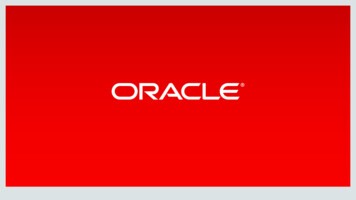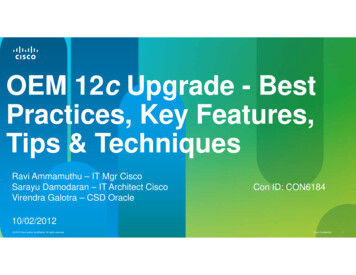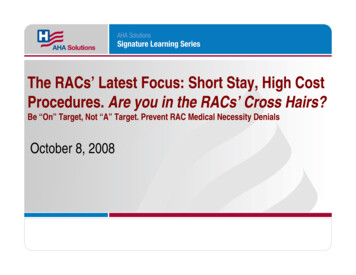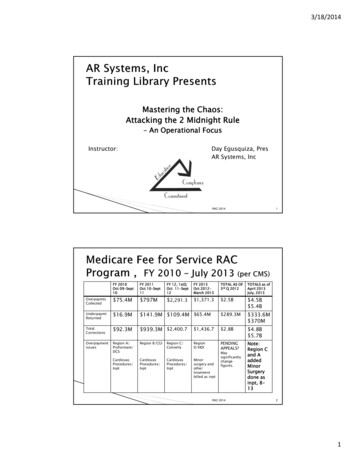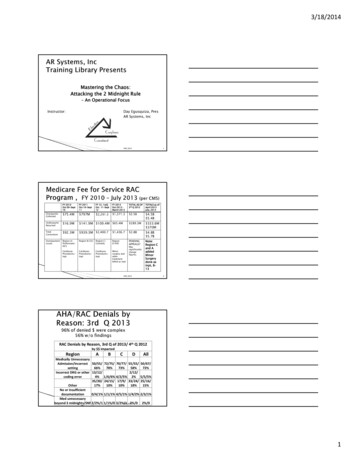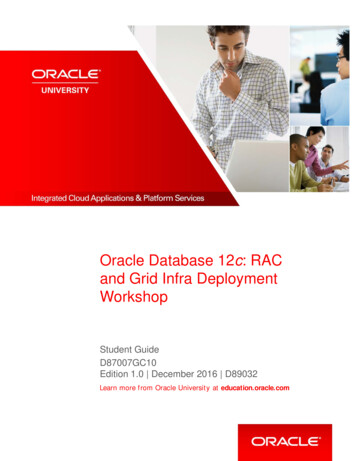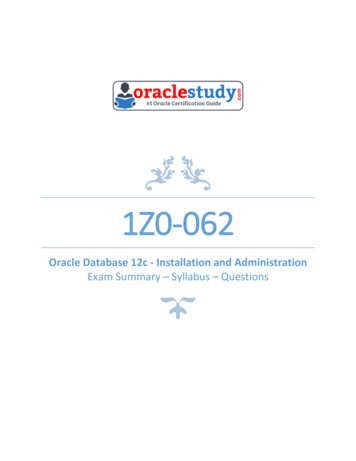
Transcription
Books for professionals by Professionals HussainFarooqShamsudeenYuRelatedExpert Oracle RAC 12cExpert Oracle RAC 12c is a hands-on book helping you understand and implementOracle Real Application Clusters (RAC), and to reduce the total-cost-of-ownership(TCO) of a RAC database. As a seasoned professional, you are probably aware of theimportance of understanding the technical details behind the RAC stack. This bookprovides deep understanding of RAC concepts and implementation details that youcan apply toward your day-to-day operational practices. You’ll be guided in troubleshooting and avoiding trouble in your installation. Successful RAC operation hingesupon a fast-performing network interconnect, and this book dedicates a chapter solelyto that very important and easily overlooked topic.All four authors are experienced RAC engineers with a wealth of hard-won experience encountering and surmounting the challenges of running a RAC environmentthat delivers on its promise. In Expert Oracle RAC 12c they provide you a framework inwhich to avoid repeating their hard-won lessons. Their goal is for you to manage yourown RAC environment with ease and expertise. Provides a deep conceptual understanding of RAC Provides best practices to implement RAC properly and match application workload Enables readers to troubleshoot RAC with easeShelve inDatabases/OracleUser level:Intermediate–AdvancedSOURCE CODE ONLINEwww.apress.comwww.it-ebooks.info
For your convenience Apress has placed some of the frontmatter material after the index. Please use the Bookmarksand Contents at a Glance links to access them.www.it-ebooks.info
Contents at a GlanceAbout the Authors xviiAbout the Technical Reviewers xixAcknowledgments xxi Chapter 1: Overview of Oracle RAC 1 Chapter 2: Clusterware Stack Management and Troubleshooting 29 Chapter 3: RAC Operational Practices 69 Chapter 4: New Features in RAC 12c 97 Chapter 5: Storage and ASM Practices 123 Chapter 6: Application Design Issues 165 Chapter 7: Managing and Optimizing a Complex RAC Environment 181 Chapter 8: Backup and Recovery in RAC 217 Chapter 9: Network Practices 243 Chapter 10: RAC Database Optimization 285 Chapter 11: Locks and Deadlocks 321 Chapter 12: Parallel Query in RAC 353 Chapter 13: Clusterware and Database Upgrades 381 Chapter 14: RAC One Node 411Index 431iiiwww.it-ebooks.info
Chapter 1Overview of Oracle RACby Kai YuIn today’s business world, with the growing importance of the Internet, more and more applications need to beavailable online all the time. One obvious example is the online store application. Many companies want to keep theironline stores open 24x7 on 365 days so that customers from everywhere, in different time zones, can come at any timeto browse products and place orders.High Availability (HA) may also be critical for non-customer-facing applications. It is very common for ITdepartments to have complex distributed applications that connect to multiple data sources, such as those that extractand summarize sales data from online store applications to reporting systems. A common characteristic of theseapplications is that any unexpected downtime could mean a huge loss of business revenue and customers. The totalloss is sometimes very hard to quantify with a dollar amount. As the key components of these applications, Oracledatabases are often key components of a whole storefront ecosystem, so their availability can impact the availability ofthe entire ecosystem.The second area is the scalability of applications. As the business grows, transaction volumes can double ortriple as compared to what was scoped for the initial capacity. Moreover, for short times, business volumes can bevery dynamic; for example, sales volumes for the holiday season can be significantly higher. An Oracle Databaseshould be scalable and flexible enough to easily adapt to business dynamics and able to expand for high workloadsand shrink when demand is reduced. Historically, the old Big Iron Unix servers that used to dominate the databaseserver market lacked the flexibility to adapt to these changes. In the last ten years, the industry standard has shifted tox86-64 architecture running on Linux to meet the scalability and flexibility needs of growing applications. Oracle RealApplication Clusters (RAC) running on Linux on commodity X86-64 servers is a widely adapted industry-standardsolution to achieve high availability and scalability.This chapter introduces the Oracle RAC technology and discusses how to achieve the high availability andscalability of the Oracle database with Oracle RAC. The following topics will be covered in this chapter: Database High Availability and Scalability Oracle Real Application Clusters (RAC) Achieving the Benefits of Oracle RAC Considerations for Deploying Oracle RACHigh Availability and ScalabilityThis section discusses the database availability and scalability requirements and their various related factors.1www.it-ebooks.info
Chapter 1 Overview of Oracle RACWhat Is High Availability?As shown in the previous example of the online store application, business urges IT departments to provide solutionsto meet the availability requirements of business applications. As the centerpiece of most business applications,database availability is the key to keeping all the applications available.In most IT organizations, Service Level Agreements (SLAs) are used to define the application availabilityagreement between business and IT organization. They can be defined as the percentage availability, or the maximumdowntime allowed per month or per year. For example, an SLA that specifies 99.999% availability means less than5.26 minutes downtime allowed annually. Sometimes an SLA also specifies the particular time window allowed fordowntime; for example, a back-end office application database can be down between midnight and 4 a.m. the firstSaturday of each quarter for scheduled maintenance such as hardware and software upgrades.Since most high availability solutions require additional hardware and/or software, the cost of these solutionscan be high. Companies should determine their HA requirements based on the nature of the applications and thecost structure. For example some back-end office applications such as a human resource application may not need tobe online 24x7. For those mission–critical business applications that need to be highly available, an evaluation of thecost of downtime may be calculated too; for example, how much money can be lost due to 1 hour of downtime. Thenwe can compare the downtime costs with the capital costs and operational expenses associated with the design andimplementation of various levels of availability solution. This kind of comparison will help business managers and ITdepartments come up with realistic SLAs that meet their real business and affordability needs and that their IT teamcan deliver.Many business applications consist of multi-tier applications that run on multiple computers in a distributednetwork. The availability of the business applications depends not only on the infrastructure that supports thesemulti-tier applications, including the server hardware, storage, network, and OS, but also on each tier of theapplications, such as web servers, application servers, and database servers. In this chapter, I will focus mainly on theavailability of the database server, which is the database administrator’s responsibility.Database availability also plays a critical role in application availability. We use downtime to refer to the periodswhen a database is unavailable. The downtime can be either unplanned downtime or planned downtime. Unplanneddowntime can occur without being prepared by system admin or DBAs—it may be caused by an unexpected eventsuch as hardware or software failure, human error, or even a natural disaster (losing a data center). Most unplanneddowntime can be anticipated; for example, when designing a cluster it is best to make the assumption that everythingwill fail, considering that most of these clusters are commodity clusters and hence have parts which break. The keywhen designing the availability of the system is to ensure that it has sufficient redundancy built into it, assumingthat every component (including the entire site) may fail. Planned downtime is usually associated with scheduledmaintenance activities such as system upgrade or migration.Unplanned downtime of the Oracle database service can be due to data loss or server failure. The data loss maybe caused by storage medium failure, data corruption, deletion of data by human error, or even data center failure.Data loss can be a very serious failure as it may turn out to be permanent, or could take a long time to recover from.The solutions to data loss consist of prevention methods and recovery methods. Prevention methods include diskmirroring by RAID (Redundant Array of Independent Disks) configurations such as RAID 1 (mirroring only) andRAID 10 (mirroring and striping) in the storage array or with ASM (Automatic Storage Management) diskgroupredundancy setting. Chapter 5 will discuss the details of the RAID configurations and ASM configurations for OracleDatabases. Recovery methods focus on getting the data back through database recovery from the previous databasebackup or flashback recovery or switching to the standby database through Data Guard failover.Server failure is usually caused by hardware or software failure. Hardware failure can be physical machinecomponent failure, network or storage connection failure; and software failure can be caused by an OS crash, orOracle database instance or ASM instance failure. Usually during server failure, data in the database remains intact.After the software or hardware issue is fixed, the database service on the failed server can be resumed after completingdatabase instance recovery and startup. Database service downtime due to server failure can be prevented byproviding redundant database servers so that the database service can fail over in case of primary server failure.Network and storage connection failure can be prevented by providing redundant network and storage connections.2www.it-ebooks.info
Chapter 1 Overview of Oracle RACPlanned downtime for an Oracle database may be scheduled for a system upgrade or migration. The databasesystem upgrade can be a hardware upgrade to servers, network, or storage; or a software upgrade to the OS, orOracle Database patching and upgrade. The downtime for the upgrade will vary depending on the nature of theupgrade. One way to avoid database downtime for system upgrades is to have a redundant system which can takeover the database workloads during the system upgrade without causing a database outage. Migration maintenanceis sometimes necessary to relocate the database to a new server, a new storage, or a new OS. Although this kind ofmigration is less frequent, the potential downtime can be much longer and has a much bigger impact on the businessapplication. Some tools and methods are designed to reduce database migration downtime: for example, Oracletransportable tablespace, Data Guard, Oracle GoldenGate, Quest SharePlex, etc.In this chapter, I focus on a specific area of Oracle Database HA: server availability. I will discuss how to reducedatabase service downtime due to server failure and system upgrade with Oracle RAC. For all other solutions toreduce or minimize both unplanned and planned downtime of Oracle Database, we can use the Oracle MaximumAvailability Architecture (MAA) as the guideline. Refer to the Oracle MAA architecture page, ability/maa-090890.html, for the latest developments.Database ScalabilityIn the database world, it is said that one should always start with application database design, SQL query tuning, anddatabase instance tuning, instead of just adding new hardware. This is always true, as with a bad application databasedesign and bad SQL queries, adding additional hardware will not solve the performance problem. On the other hand,however, even some well-tuned databases can run out of system capacity as workloads increase.In this case, the database performance issue is no longer just a tuning issue. It also becomes a scalability issue.Database scalability is about how to increase the database throughput and reduce database response time, underincreasing workloads, by adding more computing, networking, and storage resources.The three critical system resources for database systems are CPU, memory, and storage. Different types ofdatabase workloads may use these resources differently: some may be CPU bound or memory bound, while othersmay be I/O bound. To scale the database, DBAs first need to identify the major performance bottlenecks or resourcecontentions with a performance monitoring tool such as Oracle Enterprise Manager or AWR (Automatic WorkloadRepository) report. If the database is found to be I/O bound, storage needs to be scaled up. In Chapter 5, we discusshow to scale up storage by increasing storage I/O capacity such as IOPs (I/O operations per second) and decreasestorage response time with ASM striping and I/O load balancing on disk drives.If the database is found to be CPU bound or memory bound, server capacity needs to be scaled up. Serverscalability can be achieved by one of the following two methods: Scale-up or vertical scaling: adding additional CPUs and memory to the existing server. Scale-out or horizontal scaling: adding additional server(s) to the database system.The scale-up method is relatively simple. We just need to add more CPUs and memory to the server. AdditionalCPUs can be recognized by the OS and the database instance. To use the additional memory, some memory settingsmay need to be modified in OS kernel, as well as the database instance initialization parameters. This option is moreuseful with x86 servers as these servers are getting more CPUs cores and memory (up to 80 cores and 4TB memory perserver of the newer servers at the time of writing). The HP DL580 and DL980 and Dell R820 and R910 are examples ofthese powerful X86 servers. For some servers, such as those which are based on Intel’s Sandybridge and Northbridgearchitectures, adding more memory with the older CPUs might not always achieve the same memory performance.One of the biggest issues with this scale-up method is that it can hit its limit when the server has already reached themaximal CPU and memory capacity. In this case, you may have to either replace it with a more powerful server or trythe scale-out option.The scale-out option is to add more server(s) to the database by clustering these servers so that workloads can bedistributed between them. In this way, the database can double or triple its CPU and memory resources. Compared tothe scale-up method, scale-out is more scalable as you can continue adding more servers for continuously increasingworkloads.3www.it-ebooks.info
Chapter 1 Overview of Oracle RACOne of the factors that will help to determine whether the scale-up or the scale-out option is more appropriate foryour environment is the transaction performance requirements. If a lower transaction latency is the goal, the scale-upmethod may be the option to choose, as reading data from local memory is much faster than reading data from aremote server across the network due to the fact that memory speed is much faster than networking speed, even for thehigh-speed InfiniBand network. If increasing database transaction throughput is the goal, scale-out is the option to beconsidered, as it can distribute transaction loads to multiple servers to achieve much higher transaction throughput.Other factors to be considered include the costs of hardware and software licenses. While the scale-up methodmay need a high-cost, high-end server to allow vertical scalability, the scale-out method will allow you to use low-costcommodity servers clustered together. Another advantage of the scale-out method is that this solution also confers highavailability, which allows database transactions to be failed over to other low-cost servers in the cluster, while the scale-upsolution will need another high-cost server to provide a redundant configuration. However, the scale-out method usuallyneeds special licensed software such as Oracle RAC to cluster the applications on multiple nodes. While you may be ableto save some hardware costs with the scale-out model, you need to pay for the licencing cost of the cluster software.The scale-out method takes much more complex technologies to implement. Some of the challenges are how tokeep multiple servers working together on a single database while maintaining data consistency among these nodes,and how to synchronize operations on multiple nodes to achieve the best performance. Oracle RAC is designed totackle these technical challenges and make database servers work together as one single server to achieve maximumscalability of the combined resources of the multiple servers. Oracle RAC’s cache fusion technology manages cachecoherency across all nodes and provides a single consistent database system image for applications, no matter whichnodes of the RAC database the applications are connected to.Oracle RACThis section discusses Oracle RAC: its architecture, infrastructure requirements, and main components.Database Clustering ArchitectureTo achieve horizontal scalability or scale-out of a database, multiple database servers are grouped together to forma cluster infrastructure. These servers are linked by a private interconnect network and work together as a singlevirtual server that is capable of handling large application workloads. This cluster can be easily expanded or shrunk byadding or removing servers from the cluster to adapt to the dynamics of the workload. This architecture is not limitedby the maximum capacity of a single server, as the vertical scalability (scale-up) method is. There are two types ofclustering architecture: Shared Nothing Architecture Shared Everything ArchitectureThe shared nothing architecture is built on a group of independent servers with storage attached to each server.Each server carries a portion of the database. The workloads are also divided by this group of servers so that eachserver carries a predefined workload. Although this architecture can distribute the workloads among multiple servers,the distribution of the workloads and data among the servers is predefined. Adding or removing a single server wouldrequire a complete redesign and redeployment of the cluster.For those applications where each node only needs to access a part of the database, with very careful partitioningof the database and workloads, this shared nothing architecture may work. If the data partition is not completely insync with the application workload distribution on the server nodes, some nodes may need to access data stored inother nodes. In this case, database performance will suffer. Shared nothing architecture also doesn’t work well witha large set of database applications such as OLTP (Online transaction processing), which need to access the entiredatabase; this architecture will require frequent data redistribution across the nodes and will not work well. Sharednothing also doesn’t provide high availability. Since each partition is dedicated to a piece of the data and workloadwhich is not duplicated by any other server, each server can be a single point of failure. In case of the failure of anyserver, the data and workload cannot be failed over to other servers in the cluster.4www.it-ebooks.info
Chapter 1 Overview of Oracle RACIn the shared everything architecture, each server in the cluster is connected to a shared storage where the databasefiles are stored. It can be either active-passive or active-active. In the active-passive cluster architecture, at any giventime, only one server is actively accessing the database files and handling workloads; the second one is passive and instandby. In the case of active server failure, the second server picks up the access to the database files and becomes theactive server, and user connections to the database also get failed over to the second server. This active-passive clusterprovides only availability, not scalability, as at any given time only one server is handling the workloads.Examples of this type of cluster database include Microsoft SQL Server Cluster, Oracle Fail Safe, and OracleRAC One Node. Oracle RAC One Node, introduced in Oracle Database 11.2, allows the single-instance database tobe able to fail over to the other node in case of node failure. Since Oracle RAC One Node is based on the same GridInfrastructure as Oracle RAC Database, it can be converted from one node to the active-active Oracle RAC Databasewith a couple of srvctl commands. Chapter 14 will discuss the details of Oracle RAC One Node.In the active-active cluster architecture, all the servers in the cluster can actively access the database files andhandle workloads simultaneously. All database workloads are evenly distributed to all the servers. In case of one ormore server failures, the database connections and workloads on the failed servers get failed over to the rest of thesurviving servers. This active-active architecture implements database server virtualization by providing users witha virtual database service. How many actual physical database servers are behind the virtual database service, andhow the workloads get distributed to these physical servers, is transparent to users. To make this architecture scalable,adding or removing physical servers from the cluster is also transparent to users. Oracle RAC is the classic example ofthe active-active shared everything database architecture.RAC ArchitectureOracle Real Application Cluster (RAC) is an Oracle Database option, based on a share everything architecture. OracleRAC clusters multiple servers that then operate as a single system. In this cluster, each server actively accesses theshared database and forms an active-active cluster configuration. Oracle first introduced this active-active clusterdatabase solution, called Oracle Parallel Server (OPS), in Oracle 6.2 on VAX/VMS. This name was used until 2001,when Oracle released Oracle Real Application Clusters (RAC) in Oracle Database 9i. Oracle RAC supersedes OPS withmany significant enhancements including Oracle Clusterware and cache fusion technology.In the Oracle RAC configuration, the database files are stored in shared storage, which every server in the clustershares access to. As shown in Figure 1-1, the database runs across these servers by having one RAC database instanceon a server. A database instance consists of a collection of Oracle-related memory plus a set of database backgroundprocesses that run on the server. Unlike a single-node database, which is limited to one database instance per database,a RAC database has one or more database instances per database and is also built to add additional database instanceseasily. You can start with a single node or a small number of nodes as an initial configuration and scale out to morenodes with no interruption to the application. All instances of a database share concurrent access to the database files.User RACInstance3ClusterInterconnectRACDatabaseFigure 1-1. Oracle RAC Database architecture5www.it-ebooks.info
Chapter 1 Overview of Oracle RACOracle RAC is designed to provide scalability by allowing all the RAC instances to share database workloads.In this way, Oracle RAC Database presents users with a logical database server that groups computing resourcessuch as CPUs and memory from multiple RAC nodes. Most times, with proper configuration using RAC featuressuch as services, Single Client Access Name (SCAN), and database client failover features, changes on the clusterconfiguration such as adding or removing nodes can be done as transparently to the users as possible. Figure 1-1illustrates an Oracle RAC configuration where users are connected to the database and can perform databaseoperations through three database instances.This architecture also provides HA during a failure in the cluster. It can tolerate N-1 node failures, where N isthe total number of the nodes. In case of one or more nodes failing, the users connecting to the failed nodes arefailed over automatically to the surviving RAC nodes. For example, as shown in Figure 1-1, if node 2 fails, the userconnections on instance 2 fail over to instance 1 and instance 3. When user connections fail over to the survivingnodes, RAC ensures load balancing among the nodes of the cluster.Oracle RAC 12cR1 introduced a new architecture option called Flex Clusters. In this new option, there are twotypes of cluster nodes: Hub nodes and Leaf nodes. The Hub Nodes are same as the traditional cluster nodes in OracleRAC 11gR2. All of the Hub Nodes are interconnected with the high-speed interconnect network and have direct accessto shared storage. The Leaf Nodes are a new type of node with a lighter-weight stack. They are connected only with thecorresponding attached Hub Nodes and they are not connected with each other. These Leaf Nodes are not requiredto have direct access to shared storage. Instead, they will perform storage I/O through the Hub Nodes that theyattach to. The Flex Cluster architecture was introduced to improve RAC scalability. Chapter 4 will discuss the detailedconfiguration of this new feature in 12c.Hardware Requirements for RACA typical Oracle RAC database requires two or more servers, networking across the servers, and the storage sharedby the servers. Although the servers can be SMP Unix servers as well as low-cost commodity x86 servers, it has beenan industry trend to move the database server from large SMP Unix machines to low-cost x86-64 servers running onLinux OS, such as Red Hat Enterprise Linux and Oracle Linux.It is recommended that all the servers in any Oracle RAC cluster should have similar hardware architecture.It is mandatory to have the same OS, with possibly different patches among the servers on the same Oracle RAC.In order to ensure load balancing among the RAC cluster nodes, in 11gR2, server pool management is based onthe importance of the server pool and the number of servers associated with the server pool, and there is no way todifferentiate between the capacities of the servers. All the servers on the RAC cluster are assumed to have similar(homogeneous) capacity configuration such as CPU counts and total memory, as well as physical networks. If theservers are different in capacity, this will affect resource distribution and session load balancing on the RAC. In OracleRAC 12c, the policy-based cluster management can manage clusters that consist of heterogeneous servers withdifferent capabilities such as CPU power and memory sizes. With the introduction of server categorization, serverpool management has been enhanced to understand the differences between servers in the cluster.Each server should also have proper local storage for the OS, Oracle Grid Infrastructure software home, andpossibly for Oracle RAC software home if you decide to use the local disk to store the RAC Oracle Database binary.Potentially, in the event of a RAC node failure, the workloads on the failed node will be failed over to the workingnodes; so each RAC node should reserve some headroom for the computing resources to handle additional databaseworkloads that are failed over from other nodes.The storage where the RAC database files reside needs to be accessible from all the RAC nodes. OracleClusterware also stores two important pieces of Clusterware components—Oracle Cluster Registry (OCR) andvoting disk files—in the shared storage. The accessibility of the shared storage by each of the RAC nodes is criticalto Clusterware as well as to RAC Database. To ensure the fault tolerance of the storage connections, it is highlyrecommended to establish redundant network connections between the servers and shared storage. For example,to connect to a Fibre Channel (FC) storage, we need to ensure that each sever on the cluster has dual HBA(Host BusAdapter) cards with redundant fiber links connecting to two fiber channel switches, each of which connects to two6www.it-ebooks.info
Chapter 1 Overview of Oracle RACFC storage controllers. On the software side, we need to configure multipathing software to group the multiple I/O pathstogether so that
Databases/Oracle User level: Intermediate-Advanced www.apress.com SOURCE CODE ONLINE Books for professionals By professionals Expert Oracle RAC 12c Expert Oracle RAC 12c is a hands-on book helping you understand and implement Oracle Real Application Clusters (RAC), and to reduce the total-cost-of-ownership (TCO) of a RAC database.
